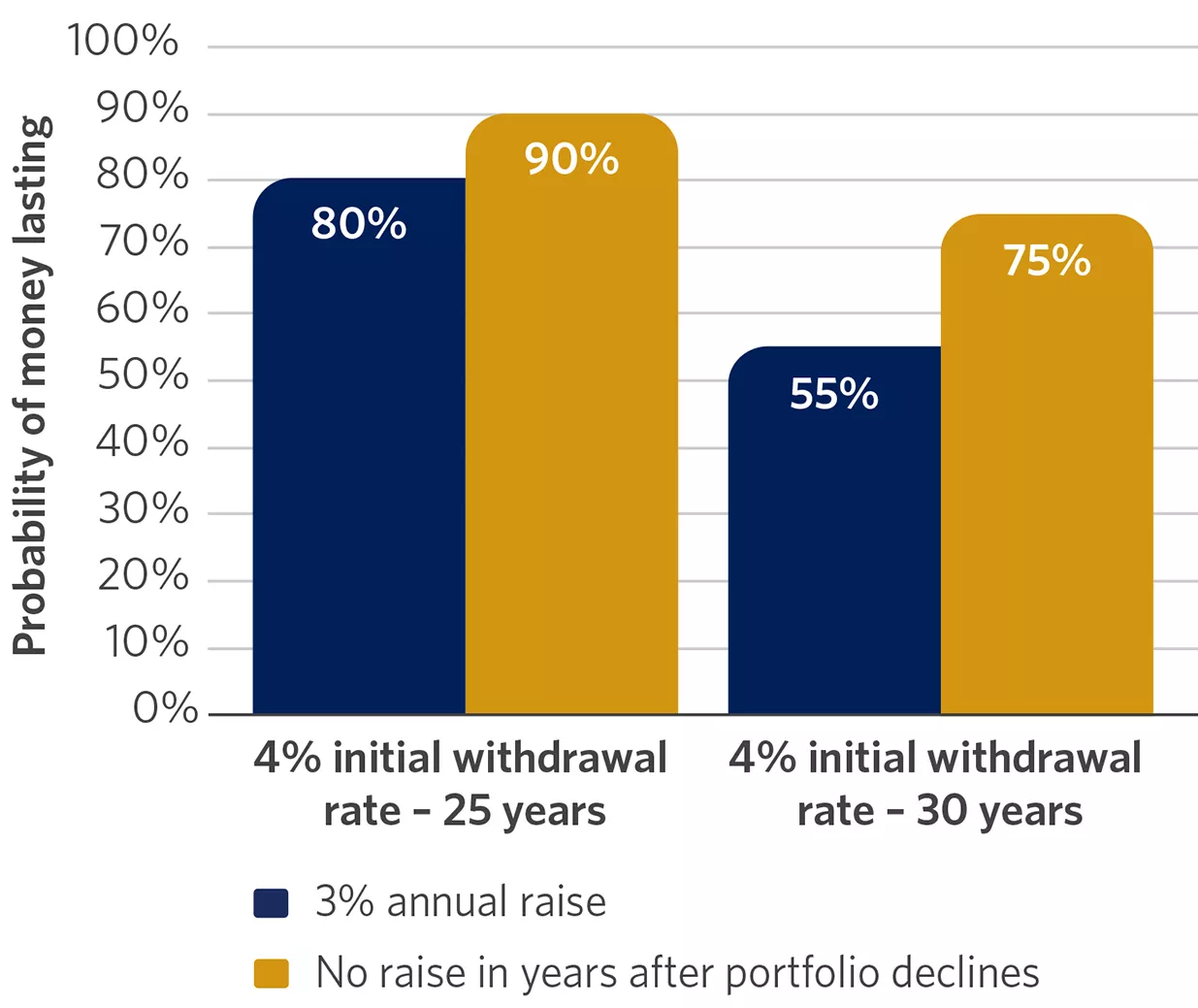Adopt lower-risk investment strategies — for the most part
You’ve saved for decades, but how should you invest your money after retirement? If you are withdrawing assets to meet your retirement income needs, you should consider keeping a year's worth of income needed from your portfolio in cash and another three to five years' worth of income in CDs and short-term fixed-income investments. This will help ensure your near-term income needs can be met and potentially prevent you from having to sell assets in a down market.
You'll also still need intermediate- and long-term fixed-income investments in your portfolio as well as growth investments, like stocks. As you age, your allocation to these types of investment should continue to decrease. But, depending on your age and life expectancy, you could still have 25 years of retirement left and you'll likely need growth investments to help keep up with inflation. Even if you're in your later retirement years, a small allocation to growth investments can provide diversification benefits, increasing your return potential without increasing your overall risk. As a reminder, diversification does not guarantee a profit or protect against loss in declining markets.
Additionally, if you’ve earmarked a portion of your assets for legacy goals, you have flexibility to take on more risk with those assets, since they have a longer time horizon.
Take your required minimum distributions
When you reach age 73, you’re generally required to start making minimum annual withdrawals from your tax-deferred retirement accounts, such as your 401(k) and traditional IRA. You’ll take a significant hit if you don’t: The IRS penalty for not taking the required minimum distribution (RMD) is 25% of the amount not taken on time.
The deadline to take your first RMD is usually April 1 of the year after you turn 73 and Dec. 31 each year after that. Your RMD for any year is the account balance as of the end of the prior calendar year divided by a life expectancy factor from the appropriate IRS table. If you’d like more information on the requirements of your RMD, be sure to get in touch with your Edward Jones financial advisor. Additionally, the IRS provides resources to help you calculate your RMD.
Make your RMD work for you
If you need your RMD to pay for your living expenses in retirement, it should be one of the first sources you draw from since you're required to take that money anyway. If you don't need it, though, consider reinvesting the cash into a taxable account, so it can continue to grow. Or, if you want that money to go to others, you can open a 529 account for your grandchildren or start a trust for your heirs.
Additionally, once you reach age 70½, you can make a qualified charitable distribution (QCD) by transferring assets directly from your IRA to a qualified charity. A QCD can satisfy all or part of your RMD from your IRA, and for 2024 you can exclude up to $105,000 of QCDs from your taxable income each year per taxpayer, which can help lower your tax bill.
Or, since it’s a good time to be thinking about your legacy, consider using your RMD to cover life insurance costs. You can put this money into an irrevocable life insurance trust, which can provide estate tax benefits and avoid gift taxes.
Designate a trusted contact
Identify a trusted contact whom your financial advisor can reach if your advisor is worried that you may be subject to financial fraud or exploitation, or experiencing diminished capacity. This should be someone (a family member, neighbor, friend, etc.) you can rely on and trust. This person would not be given account information, however, or have the power to make decisions for you.
Review your estate plan
You’ve secured your own financial future, but what about the situations your heirs will find themselves in after your death? Now is the time to put together an estate plan if you haven’t already. It's also important to review your estate plan regularly to ensure it's still aligned with your wishes, especially after marriage, divorce or other life changes. This includes reviewing:
- Your will, which outlines how you want your estate to be handled upon your death.
- Your incapacity documents, which would include designating a financial power of attorney and health care power of attorney, as well as completing a health care directive.
- Your trust (if applicable), which allows you to designate a trustee to oversee the use of an asset on behalf of a beneficiary.
- Your beneficiary designations on your retirement accounts and life insurance policies as well as any Transfers or Payables on Death (TOD and POD) you may have on other accounts and property.
If leaving a financial legacy is important to you, you'll also want to review whether you are on track to meet your legacy goal.
How Edward Jones can help
If you’re interested in learning more about how Edward Jones can help you create an effective strategy for achieving your financial goals, reach out to an Edward Jones financial advisor today for a no-obligation consultation.


